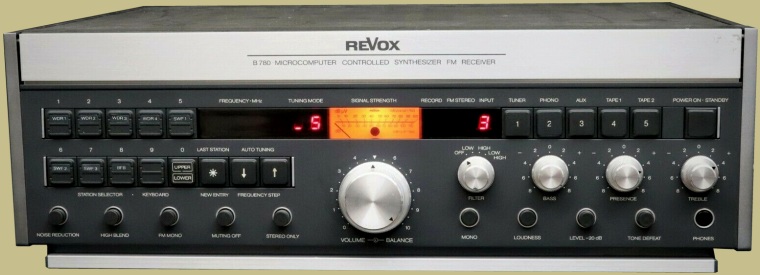
Revox, the consumer division of Studer, is probably more known for their fantastic reel-to-reel machines, such as the B77 and PR99, than anything else. However, this German made Revox B780 is one fine receiver and was introduced to the market in 1980. It is not an AM/FM receiver. It is FM only and produces 70 watts per channel into 8 ohms with no more than 0.05% total harmonic distortion.
It definitely has a distinctive appearance and looks a little more like a piece of electronic test equipment you’d see in a lab rather than a receiver. There is something about the look that is appealing though. I guess the stereo has a feel of precision to it.
Revox had a company credo at the time:
Sonic accuracy above all else.
Pretty straightforward credo. To achieve this Revox took their B760 digital frequency synthesizer tuner and their B750 mkII integrated amplifier, re-engineered them into what they called a ‘symbiotic relationship’, and created the B780. You would think that taking two components and melding them together into one box would require some sacrifice. But, Revox actually made some improvements to their tuner and amplifier circuitry when they designed the B780. They did this through the use of a microprocessor chip which made the switching functions far more efficient. That’s why the it’s called the Revox B 780 Microcomputer Controlled Synthesizer FM Receiver!
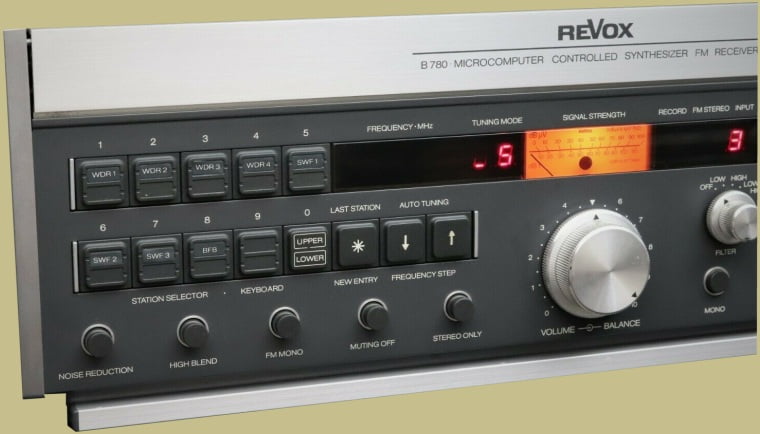
There is no tuning knob on the Revox B780. Instead stations are selected by using the push buttons. To select a station manually, using the ‘keyboard’, you just type in the digits using the numbered push buttons and the tuner will jump to that station. There are actually three ways to tune in an FM station on the B780:
- Direct entry of frequencies in 25kHz steps via numbered keypads.
- Frequency step up/down counting in 25kHz steps (hold the tuning button down).
- Auto tuning in 50kHz steps.
As you can see the current frequency will show on the digital display as will the method of tuning. The B780 has memory space for 18 station presets. If you happen to have the Revox antenna control accessory then your B780 will control your antenna (a Yagi?) as well. Each time a preset station is selected the B780 will automatically adjust the antenna. Not so useful these days but still a cool feature. I’m going to guess that the antenna control module is probably pretty hard to find nowadays. All preset stations will stay in memory when the unit is turned off unless the rechargeable batteries fail. Then you’re out of luck.
In the middle of the B780, above the volume/balance knob is a beautiful gold analog signal strength meter. Why they used an analog meter I’m not sure but it sure does look nice and gives the industrial looking B780 a bit of warmth.

The filter selector gives you the choice of using a hi-cut filter, a low-cut filter or both filters at the same time. The B780 also has Bass, Treble and Presence controls. These can be overridden via the tone defeat button. The Level -20dB button is used when you might need to lower the volume such as during a phone call. Push the button and volume is reduced by 20 decibels instantly. Push the button again and volume goes back to your original setting.
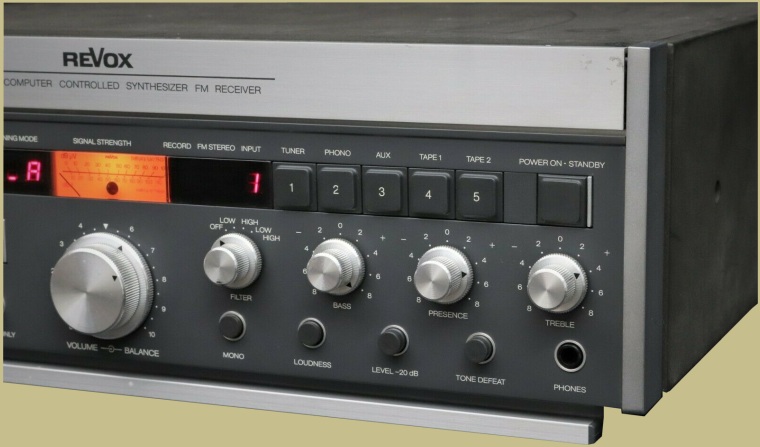
Instead of a rotary selector switch, Revox used large push buttons for selecting the source as well as for the power switch. The input source selected is shown digitally on the display to the left of the buttons. It will also display the input and the record destination on the digital display when recording from say Phono to Tape.
Below you can see the fold up panel along the top of the B780. It hides the less frequently used controls such as the memory store button, de-emphasis button, speaker select buttons, record output buttons and a pre-amp output jack. When setting a preset station just tune in the station, flip up the panel, and push the Store Memory button, then the number for the preset (upper or lower, 1-9), then tune the station, then push store memory.
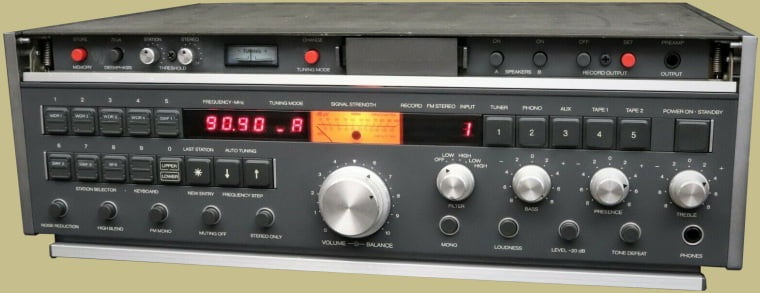
The original industrial looking color of the B780 is Dark Anthracite from Nextel. It has an almost suede feel to it.
That small panel in the middle under the fold up panel is for 3 batteries. Push in the side tabs and the drawer will slide out. The batteries are used to maintain the station presets when the unit is off. They are IEC KR 15/51 batteries which I believe are rechargeable AA batteries. If you’re looking at buying a B780 be sure to check this battery compartment. Sometimes old batteries have been left in there for many years and the acid will leak out and ruin the connections.
Specifications:
- Tuning range: FM
- Power output: 80 watts per channel into 8Ω (stereo)
- Frequency response: 20Hz to 20kHz
- Total harmonic distortion: 0.03%
- Damping factor: 100
- Input sensitivity: 3mV (MM), 150mV (line)
- Signal to noise ratio: 73dB (MM), 90dB (line)
- Output: 0.85V (Pre out)
- Dimensions: 452 x 151 x 420 mm / 17.8 x 6 x 16.5 inches
- Weight: 17 kg / 37 lbs
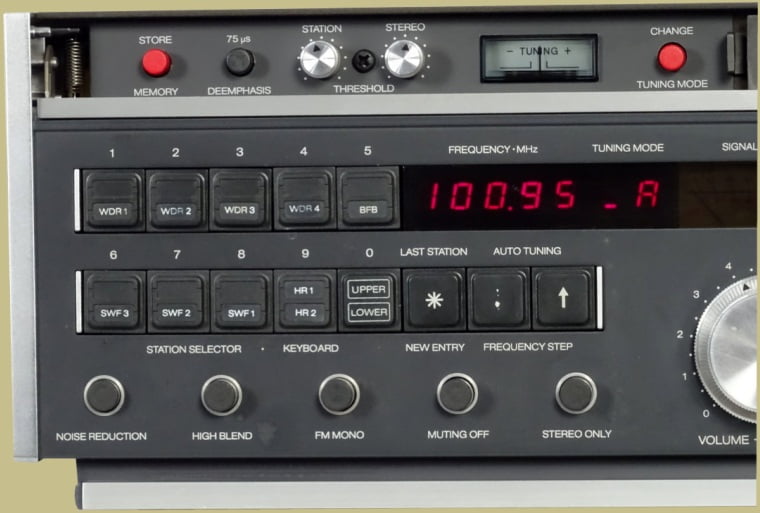
Inside the B780 somewhat of a modular design as if it was built to military specs. Each board can be easily removed but they are also double sided which can make for some difficult soldering. The wiring harness is very well laid out. But, the circuit boards aren’t marked at all and the components and polarity are not listed. So, if you’re recapping one of these, mark the polarity before you pull the originals. Another quirk is that the output transistors are mounted to an internal heatsink which is then mounted to the main heatsink at the back of the unit.
Not only does the Revox B780 have the usual protection circuitry for the speaker outputs it also has thermal sensors on the heat sink and power transformer and will shut down the unit should the need arise.
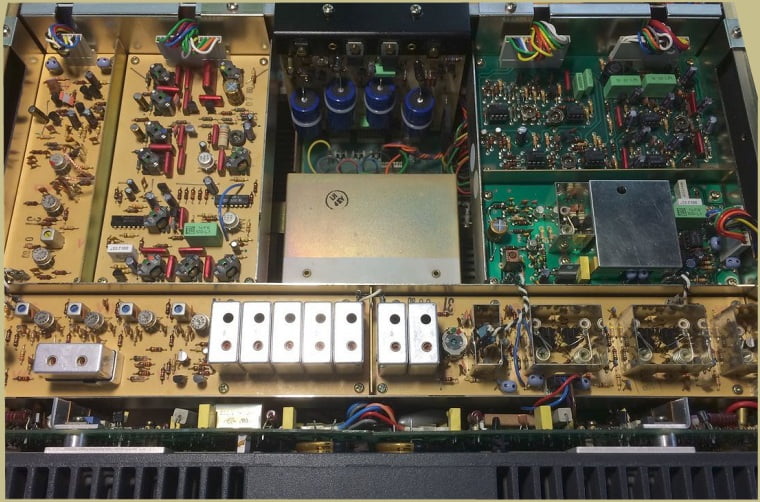
One problem with the B780 is that the old Nextel coating (paint) can become soft and sticky. Some have used Montana brand spray paint in the black anthracite color to get a close, but not exact match. As mentioned above, the original Nextel has a suede like feel which can’t be reproduced with most spray paint.
The RCA jacks aren’t the easiest to get to as they are tucked up under the huge heat sink. There is an oscilloscope connection on the back panel for trouble shooting. There are two sets of speaker outputs but it looks like the A speakers are a DIN connection.
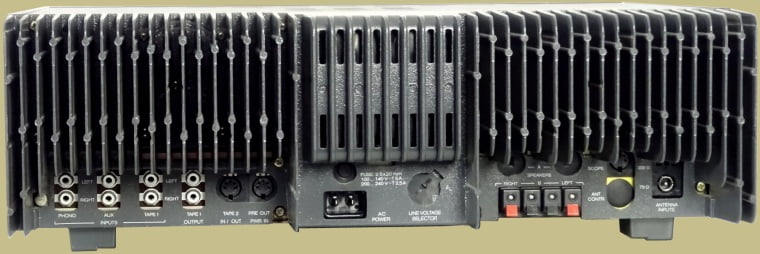
If you find a Revox B780 that is original it will more than likely need some restoration. The gold Frako capacitors that were used in it fail frequently and will probably need replaced. The Nextel finish is usually past its prime as well. Still, the Revox B780 is an exceptional receiver and worth restoration. Once up to spec there aren’t many other receivers that can match it’s versatility and performance. It is also a very unique stereo, one that will draw the attention of anyone that sees it.
Cái volume có vẻ lỏng lẻo quá
jhjhjhhjhjhjhjh
In my opinion this receiver a very good looking and very good sounding item. I bought mine used for 950 €. The main thing is the condition of the front plate without scratches and other marks. Also knobs and buttons have to be complete. The Nextel painting can be redone for about 200 €.
Revox wasn’t cheap in the past nor is it in present days. A complete service is needed after decades of using. This cost about 350..500€, depending on the demands. But even in original condition my Revox was much better than my Denon amp (PMA 980R).
Overall the B780 sounds very good in my opinion. Rich, deep bass, detailed mids and beautiful treble are the main characteristics. Of course there are receivers or amps that sound better, but with the B780 you can’t really go wrong. My receiver powers a pair of JBL 4312 G through Kimber 4pr and I’m really satisfied.
Disadvantages are the depth of the item, the narrow distance of the cinch-sockets, the tiny speaker-connections and the DIN-socket for tape 2.
Positives are the FM-tuner, the electronic Rec-out- and source-selector, the logarithmic volume controller, the phono section and the tone control including loudness-button.
If you like the brand, the design and you can get a B780 in nice condition-grab it! There’s almost nothing that can’t be repaired. Once it is refurbished, it will provide decades of pleasure!
Hi there. I have two Mostek 3872, new old stock, for sale. As i heard, this chip has been used in the Revox B780.
Be aware that the DIN connections all contain internal switches that are notorious for oxidation and causing anything from channel loss, to imbalance to just loss of highs. When restored, be sure to open them up (especially the preamp out) and clean the switches.
Also, the bulb used to illuminate the signal strength meter tends to make the surrounding plastic brittle. Be careful around it. I replaced it with a warm LED.
Howdy
What LED did you use? how did you mount it? Any pics?
Thanks